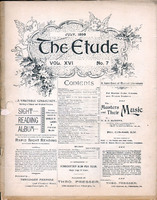S. N. PENFIELD.
Teachers differ widely and unaccountably in the value they place upon the use of the metronome. I say “unaccountably,” for it does seem that the value and the limitations of the little machine must be evident to any practical pianist who has ever made use of it. The teacher who has never used a metronome will have some novel experiences the first time he uses one.
Perhaps you remember your first attempt to board a moving trolley car, how you grasped the handle and as you were jerked away made a violent and perhaps fruitless effort to plant your foot on the step. You either measured your length in the dust, or found yourself instantly and with nervous shock in full motion.
So with a metronome. You set the instrument in motion, then catch on with it, as best you can, becoming in course of time, as in car entering, quite an adept. A steady tempo must, indeed, be kept, which does not mean the cast-iron tempo of the metronome. The piece does not exist in which each and every pulsation (beat) should be mathematically the same as all others. But just this error is made with the metronome as a guide. The pupil’s effort should be to establish a mental metronome which, while steady, is elastic enough to suit the requirements of the music. How may we acquire this? Nothing can take the place of audible counting until steadiness is secured,—then mental counting.
There is no trouble in “catching on,” and it is elastic. To be sure it is frequently too elastic, and, therefore, occasional test with a metronome is certainly useful. But I must protest against the following sentence found in a recent article in a musical magazine. “Every exercise and every piece ought to be practiced with the metronome, hands separately and hands together.” This is the undoubted way to make mechanical players. One is not surprised to find in the same article that a chief advantage of metronome use is that a student on discovering that he can play 200 notes to a minute becomes ambitious to reach 250 per minute. That reached, then to try for 300, etc., as if approximation to 1000 per minute must make ideal music! No, the metronome is invaluable in its true place, which is firstly the indication to the world of the true tempo of a piece or a movement, secondly, the occasional testing of various passages to see whether one has unconsciously hurried or retarded. Beyond this Maelzel’s invaluable little contrivance is as much out of place as a cat in a strange garret.



